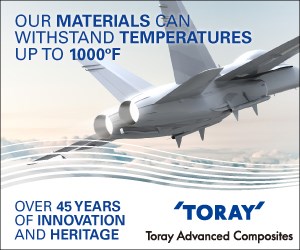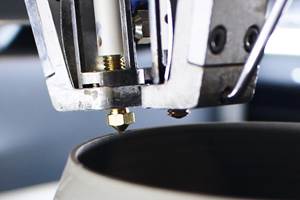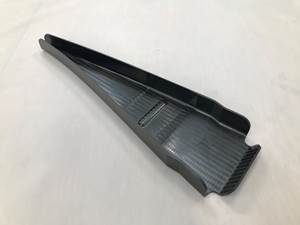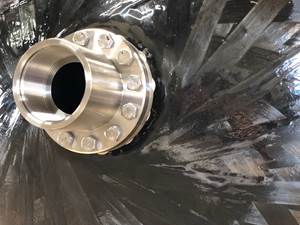Boeing conducts inspections of 787 composite inner fuselage skin
Boeing reports that it is checking the flatness of inner fuselage skins on all undelivered 787s to verify structural integrity.

Assembly of first 787-10 at Boeing’s final assembly line in North Charleston, S.C., U.S.
Photo Credit: Boeing
The Boeing Co. (Chicago, Ill., U.S.) reports that an inner fuselage skin surface nonconformity initially discovered in fuselage Sections 47 and 48, the two aftbody fuselage sections of the composites-intensive 787, has been found to exist in other fuselage sections as well, prompting the aircraft manufacturer to perform a complete inspection of fuselage joins in all undelivered 787s at the company’s final assembly locations in Everett, Wash., U.S., and North Charleston, S.C., U.S.
As part of this inspection regime, Boeing has asked each of its fuselage suppliers to conduct similar inspections for the nonconformity at their facilities, says a Boeing spokesperson. The skin surface nonconformity is not deemed to pose an immediate flight safety risk and in-service 787s are not currently a target of the inspection program.
The potentially affected areas of the aircraft are the carbon fiber composite inner fuselage skin near each join, where one fuselage section is mated with another. The Boeing spokesperson says the inner mold line (IML) of each fuselage mating surface is required to maintain flatness to within 0.005 inch over a 5-inch span. Where present, the anomaly does not meet 787 design criteria, which may prompt corrective action, depending the severity of the disconformity. Boeing’s spokesperson says a root cause analysis of the problem is still underway.
The 787 is composed of six fuselage sections manufactured by four Tier 1 airframers. Section 41, which includes the cockpit, galley, front doors and the first few rows of seats, is manufactured by Spirit AeroSystems (Wichita, Kan., U.S.). Section 43, the shortest, is the second section, manufactured by Kawasaki Heavy Industries (Tokyo, Japan). Section 44 (the over-the-wing “bonnet” piece) and Section 46 (the fuselage section just aft of the center wing box) are fabricated by Leonardo (Rome, Italy). The aft two sections, Sections 47 and 48, are fabricated by Boeing in North Charleston. All fuselage sections are delivered to Boeing 787 final assembly lines in North Charleston and Everett.
All 787 fuselage sections, regardless of supplier, are fabricated as barrels on a metallic or composite mandrel with prepregged carbon fiber applied via automated fiber placement (AFP). The prepreg, which is used throughout all composite structural parts on the 787, is comprised of Toray’s (Tokyo) T800S intermediate modulus carbon fiber and Toray’s 3900 series toughened epoxy. AFP is performed with equipment provided by a variety of suppliers, depending on the airframer. Because the fuselage sections are IML-critical, the mandrels are segmented and designed to be disassembled for removal after autoclave cure of the prepreg layups.
How we got here
The initial discovery of the IML anomaly, says the Boeing spokesperson, is indirectly related to an August 2019 issue Boeing identified with the shims the company manufactures to join fuselage Sections 47 and 48 of the 787. Boeing uses an automated, laser-based system to measure the mating surface of each section; these measurements are then used to fabricate — also via automation — shims for the join.
A software notification designed to alert when a shim exceeded the maximum thickness per engineering specifications was not being used, which led to shims being produced that may not have fully met engineering requirements. The Boeing spokesperson says the improperly sized shims did not affect the structural integrity of the join and did not pose a threat to flight safety. Boeing says the aircraft affected by the shim sizing issue were all manufactured earlier in 2019 and that the automated shim production system was immediately corrected in production.
Then, in August 2020, as part of its quality assurance program, Boeing discovered the IML disconformity in Sections 47 and 48. Further, says the Boeing spokesperson, Boeing determined that an IML anomaly coincident with the earlier shim issue created an unacceptable violation of design criteria that could, under certain load conditions, lead to structural failure. Eight 787s were identified to have the IML anomaly and improperly sized shims between Sections 47 and 48. These eight aircraft were taken out of service for repair. Boeing’s spokesperson says a majority of those eight aircraft have returned to service.
The discovery of the IML anomaly in Sections 47 and 48 prompted Boeing to expand its assessment of IML conformance to other fuselage sections, which led to the most recent decision to expand inspections of all undelivered aircraft. The U.S. Federal Aviation Admin. (FAA) is aware of the IML issue and Boeing is working closely with the agency on the inspection program. Boeing’s spokesperson says the company’s assessment following the current inspections will guide decision-making regarding what, if any, action might be required for in-service aircraft.
Related Content
Plant tour: Joby Aviation, Marina, Calif., U.S.
As the advanced air mobility market begins to take shape, market leader Joby Aviation works to industrialize composites manufacturing for its first-generation, composites-intensive, all-electric air taxi.
Read MoreA new era for ceramic matrix composites
CMC is expanding, with new fiber production in Europe, faster processes and higher temperature materials enabling applications for industry, hypersonics and New Space.
Read MoreASCEND program update: Designing next-gen, high-rate auto and aerospace composites
GKN Aerospace, McLaren Automotive and U.K.-based partners share goals and progress aiming at high-rate, Industry 4.0-enabled, sustainable materials and processes.
Read MoreInfinite Composites: Type V tanks for space, hydrogen, automotive and more
After a decade of proving its linerless, weight-saving composite tanks with NASA and more than 30 aerospace companies, this CryoSphere pioneer is scaling for growth in commercial space and sustainable transportation on Earth.
Read MoreRead Next
Developing bonded composite repair for ships, offshore units
Bureau Veritas and industry partners issue guidelines and pave the way for certification via StrengthBond Offshore project.
Read MoreVIDEO: High-volume processing for fiberglass components
Cannon Ergos, a company specializing in high-ton presses and equipment for composites fabrication and plastics processing, displayed automotive and industrial components at CAMX 2024.
Read More“Structured air” TPS safeguards composite structures
Powered by an 85% air/15% pure polyimide aerogel, Blueshift’s novel material system protects structures during transient thermal events from -200°C to beyond 2400°C for rockets, battery boxes and more.
Read More

























